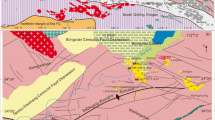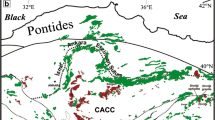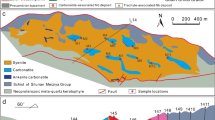Abstract
A new type of REE tetrad effect, a composite M- and W-type, was recognized in the K-feldsparthized and silicificated Shuiquangou alkaline syenites, Dongping, Hebei Province. Different analytical methods such as ICP-MS and isotopic dilution thermal ion mass spectrometer were exploited to verify the REE concentrations of the samples in three laboratories in China, France and Korea. The results are reliable and consistent within errors. In situ quantitative analysis of REE concentrations of individual zircons and apatites extracted from the very same sample has shown that fractional crystallization of magma and the superimposed hydrothermal alteration might have taken place in at least two-stage hydrothermal activities to generate the composite M- and W-type REE tetrad effect. The coexisting melt and aqueous phases, the superimposed alteration by volatile (Cl, CO2)− and Si, K, Al-enriched high temperature hydrothermal fluids might be the important facts for this new MW-type of REE tetrad effect. In addition, the peculiar MW-type tetrad effect might be an indicator for Au mineralization of reworked plutons.
Similar content being viewed by others
References
Henderson P. General geochemical properties and abundances of the rare earth elements. In: Henderson P, ed. Rare Earth Element Geochemistry. Amsterdam: Elesevier, 1984. 8–9
Masuda A. Regularities in variation of relative abundances of lanthanide elements and an attempt to analyse separation-index patterns of some minerals. J Earth Sci Nagoya Univ, 1962, 10: 173–187
Coryell C G, Chase J W, Winchester J W. A procedure for geochemical intepratation of terristerial rare-earth abundance patterns. J Geophys Res, 1963, 68: 559–566
Masuda A, Ikeuchi Y. Lanthanide tetrad effect observed in marine environment. Geochem J, 1979, 13: 19–22
Hidaka H, Holliger P, Shimizu H, et al. Lanthanide tetrad effect observed in the Oklo and ordinary uraninites and its application for their forming processes. Geochem J, 1992, 26: 337–346
Akagi T, Shabani M B, Masuda A. Lanthanide tetrad effect in kimuraite [CaY2(CO3)4·6H2O]: Implication for a new geochemical index. Geochim Cosmochim Acta, 1993, 57: 2899–2905
Takahashi Y, Yoshida H, Sato N, et al. W-and M-type tetrad effects in REE patterns for water-rock systems in the Tono uranium deposit, central Japan. Chem Geol, 2002, 184: 311–335
Zhao Z H. Preliminary report on the REE tetrad effect in granites (in Chinese). Geol Geochem, 1988, 1: 71–72
Zhao Z H. REE tetrad effect-an important indicator for water/melts (rock) interaction (in Chinese). In: Proceedings of the 3rd Congress on Mineralogy, Petrology and Geochemistry Symposium of China. Chongqing: Chongqing Branch of Science and Technology Press of China, 1988. 47–49
Zhao Z H, Masuda A. REE evidence for warter-rock interaction in tin/tungsten granites. In: The Fifth International Symposium on Tin/Tungsten Granites in Southeast Asia and the Western Pacific, Matsue, Japan (Extended abstract), 1988. 257–258
Masuda A, Kawakami O, Dohmoto Y, et al. Lanthanide tetrad effects in nature: two mutually opposite types, W and M. Geochem J, 1987, 21: 119–124
Fideslis I, Siekierski S. The regularities in stability constraints of some rare earth complexes. J Inorg Nucl Chem, 1966, 28: 185–188
Peppard D F, Mason G W, Lewey S. A tetrad effect in the liquid-liquid extraction ordering of lanthanides (III). J Inorg Nucl Chem, 1969, 31: 2271–2272
Zhao Z H, Masuda A, Shabani M B. Tetrad effect in rare metal granites (in Chinese). Geochimica, 1992, 3: 221–233
Zhao Z H, Masuda A, Shabani M B. REE tetrad effects in rare metal granite. Chin J Geochem, 1993, 12: 206–219
Jolliff B L, Papike J J, Shearer C K. Inter- and intro-crystal REE variations in apatite from the Bob Ingersoll Pegmatite, Black Hills, South Dakota. Geochim Cosmochim Acta, 1989, 53: 429–441
Yurimoto H, Duke E F, Opapike J J, et al. Are discontinuous chondritenormalized REE patterns in pegmatic granite systems the results of monazite fractionation? Geochim Cosmochim Acta, 1990, 54: 2141–2145
McLennan S M. Rare earth element geochemistry and the “tetrad” effect. Geochim Cosmochim Acta, 1994, 58: 2025–2033
Bau M. Controls on the fractionation of isovalent trace elements in magmatic and aqueous systems: Evidence from Y/Ho, Zr/Hf and lanthanide tetrad effect. Contrib Mineral Petrol, 1996, 123: 323–333
Irber W. The lanthanide tetrad effect and its correlation with K/Rb, Eu/Eu*, Sr/Eu, Y/Ho and Zr/Hf of evolving peraluminous granite suits. Geochim Cosmochim Acta, 1999, 63: 489–508
Zhao Z H, Xiong X L, Han X D. Discussion on the forming of REE tetrad effect in granites (in Chinese). Sci China Ser D, 1999, 29: 331–338
Zhao Z H, Xiong X L, Han X D, et al. Controls on the REE tetrad effect in granites: Evidence from the Qianlishan and Baerzhe granites, China. Geochim J, 2002, 36: 527–543
Moneck T, Kemfe U, Monecke J, et al. tetrad effect in rare earth element distribution patterns: A method of quantification with application to rock and mineral samples from granitic-related rare metal deposits. Geochim Cosmochim Acta, 2002, 66: 1185–1196
Liu C Q, Zhang H. The lanthanide tetrad effect in apatite from the Altay No.3 pegmatite, Xinjiang, China: An intrinsic feature of the pegmatite magma. Chem Geol, 2005, 214: 61–77
Ji J F. M-type REE tetrad effect of low temperature stibnite and its geochemical significances in west Hunan (in Chinese). Bull Mineral Petrol Geochem, 1993, 70
Peng J T, Hu RZ, Zhao J H, et al. REE geochemistry of scheelites in W-Sb-Au deposits in west Hunan (in Chinese). Geochimica, 2005, 34: 115–122
Hong W X, He S Y, Huang S H, et al. W-type of REE tetrad effect of monazite and its geological significance (in Chinese). Prog Nat Sci, 1999, 9(Supp): 1287–1290
Liu C Q, Masuda A, Okada A, et al. Ageochemical study of loess and desert sand in northern China: Implication for continental crust weathering and composition. Chem Geol, 1993, 106: 359–374
Veksler I V, Dorfman A M, Kamenetsky M, et al. Partitioning of lanthanides and Y between immiscible silicate and fluoride melts, fluorite and cryolite and the origin of the lanthanide tetrad effect in igneous rocks. Geochim Cosmoch Acta, 2005, 69: 2847–2860
Mayanovic R A, Anderson A J, Bassett W A, et al. The structure and stability of aqueous rare-earth elements in hydrothermal fluids: New results on neodymium (III) aqua and chloroaqua complex in aqueous solutions to 500 and 520 MPa. Chem Geol, 2009, 259: 30–38
Zhao Z H, Bao Z W, Lee Seung-Gu, et al. A composite M-With W-type of REE tetrad effect in a north China alkaline complex. Geochim Cosmochim Acta, 2008, 72(Supp): 11095
Liu Y, Liu H C, Li X H. Simultaneous and precise determination of 40 trace elements in rock samples using ICP-MS. Geochimica, 1996, 25: 552–558
Yuan H L, Gao S, Liu X M, et al. Accurate U-Pb age and trace element determinations of zircons by laser ablation-inductively coupled plusmamass spectrometry. Geos Geoanal Res, 2004, 28: 1511–1520
Guo C J. Mineralogical Chemistry of Rare Elements (in Chinese). Beijing: Science Press, 1965. 227–228
Wang Z G, Yu X Y, Zhao Z H. Rare Element Geochemistry (in Chinese). Beijing: Science Press, 1989. 58–62
Watson E B, Green T H. Apatite/liquid partition coefficients for the rare earth elements and strontium. Earth Planet Sci Lett, 1981, 56: 408–421
Fujimaki H. Partition coefficients of Hf, Zr and REE between zircon, apatite and liquid. Contrib Mineral Petrol, 1986, 94: 42–45
Ayers J C, Watson E B. Apatite/fluid partitioning of rare-earth elements and strontium: experimental results at 1.0 GPa and 1000°C and applications to models of fluid-rock interaction. Chem Geol, 1993, 110: 299–314
Rubin J N, Henry C D, Price J G. Hydrothermal zircons and zircon overgrowths, Sierra Blanca Peaks, Texas. Am Mineral, 1989, 74: 865–869
Kerrich R, King R. Hydrothermal zircon and baddeleyite in Val-Dor Archean mesothermal gold deposits: Characteristics, compositions and fluid-inclusion properties, with implications for timing of primary gold mineralization. Can J Earth Sci, 1993, 30: 2334–2352
Hoskin P W O, Schaltegger U. The composition of zircon and igneous and metamorphic petrogenesis. In: Hanchar J M, Hoskin P W O, eds. Zircon. Rev Mineral Geochem, 2003, 53: 27–62
Hoskin P W O. Trace-element composition of hydrothermal zircon and the alteration of hadean zircon from the Jack Hills, Australia. Geochim Cosmochim Acta, 2005, 69: 637–648
Fu B, Page F Z, Cavosie A J, et al. Ti-in-zircon thermometry: Applications and limitations. Contrib Mineral Petrol, 2008, 156: 197–215
Hoskin P W O. Minor and trace element analysis of natural zircon (ZrSiO4) by SIMS and laser ablation ICPMS: A consideration and comparison of two broadly competitive techniques. J Trace Microprobe Tech, 1998, 16: 301–326
Wu Y B, Zheng Y F. Constraints on the interpretation of Zircon U-Pb dating based on the investigation of the zircon mineralogy (in Chinese). Chin Sci Bull, 2004, 16: 1589–1603
Xie L, Wang R C, Wang D Z et al. Hydrothermal zircon—A unusual zircon (in Chinese). In: Chen J, ed. Prog Geol Geochemi. Nanjing: Nanjing University Press, 2006. 325–333
Song G R, Zhao Z H. Geology of Dongping Alkaline Complexhosted Gold Deposit in Hebei Province (in Chinese). Beijing: Seismic Publishing House, 1996. 1–170
Miao L C, Qiu Y M, McNaughton N, et al. SHRIMP U-Pb zircon geochronology of granitoids from Dongping area, Hebei Province, China: Constraints on tectonic evolution and geodynamic setting for gold metallogeny. Ore Geol Rev, 2002, 19: 187–204
Li H M, Li H K, Lu S N, et al. Determination of age of gold mineralization of Donping gold deposits by U-Pb dating hydrothermal zircons from ore veins (in Chinese). Acta Geosci Sin, 1997, 18(Supp): 176–178
Jiang N, Liu Y S, Zhou W G, et al. Derivation of Mesozoic adakitic magmas from ancient lower crust in the North China craton. Geochim Cosmochim Acta, 2007, 71: 2591–2608
Yang J H, Wu F Y, Shao J A, et al. In-situ U-Pb dating and Hf isotopic analyses of zircons from volcanic rocks of Houcheng and Zhangjiakou formations in the Zhangxuan area (in Chinese). Earth Sci J Chin Univ Geosci, 2006, 31: 71–80
Lu D L, Luo X Q, Wang J J, et al. Geochronological study on the Dongping gold deposit (in Chinese). Mineral Deposits, 1993, 12: 182–188
Hu D X, Luo G L. 40Ar/39Ar age of Au-bearing quartz veins in the Zhangjiakou and Xuanhua area (in Chinese). Sci Geol, 1994, 29: 151–158
Wang R R. The characteristics and genesis of the felsic alkali complex, Jinjiazhuang, Hebei (in Chinese). J Guilin Coll Geol, 1992, 12: 12–20
Jiang S H, Nie F J. 40Ar/39Argeochronology of the Shuiquangou alkaline complex and related gold deposit, Northwest Hebei, China (in Chinese). Geol Rev, 2000, 46: 621–627
Xu X W, Cai X P, Liu Y L, et al. Laser probe 40Ar/39Arages of metasomatic K-feldspar from the Hougou gold deposit, northwest Hebei Province. Sci China Ser D-Earth Sci, 2002, 45: 559–564
Hart C J R, Goldfarb R J, Qiu Y M, et al. Gold deposits of the northern margin of the North China Craton: Multiple late Paleozoic-mesozoic mineralizing events. Miner Depos, 2002, 37: 326–351
Mo C H. The geochemistry and genesis of gold deposits in Zhangjiakou area (in Chinese). Dissertation for the Doctoral Degree. Guangzhou: Guangzhou Institute of Geochemistry, Chinese Academy of Sciences, 1996, 48
Xiang S Y, Ye J L, Liu J. The genesis of Hougou-Shuiquangou alkalisyenite rock mass and the relation between it and the mineralization of gold deposits (in Chinese). Geoscience, 1992, 6: 55–62
Song R X, et al. A research report on the characteristics, related Au mineralization and prospect of Shuiquangou-Dananshan monzonite complex in Zhangjiakou area (in Chinese). 1992
Wang Y, Jiang X M, Shang M Y, et al. The genesis and characteristics of gold deposits related with alkaline rocks in northwest Hebei (in Chinese). Geol Rev, 1994, 4: 368–376
Zhang Z C. Characteristics of H and O isotopes and fluid evolution in Dongping gold deposit (in Chinese). Gold Geol, 1996, 2: 36–41
Deng N D. Geology and prospect of gold deposits in Zhangjiakou area. A research report, 1988
Fan H R, Xie Y H, Zhai M G. Ore-forming fluids in the Dongping gold deposit, northwest Hebei Province. Sci China Ser D-Earth Sci, 2001, 44: 748–757
Alderton D H M, Pearce J A, Potts P J. Rare earth element mobility during granite alteration: Evidence from southwest England. Earth Planet Sci Lett, 1980, 49: 149–165
Humphris S E. The mobility of the rare earth element in crust. In: Henderson P, ed. Rare Earth Element Geochemistry. Amsterdam: Elsevier, 1984. 317–342
Grauch R I. Rare earth elements in metamorphic rocks. In: Lipin B R, McKay G A, eds. Geochemistry and rare earth elements. Rev Mineral, 1989, 21: 147–167
Bao Z W, Zhao Z H. Pare-earth element mobility during ore-forming process of Dongping gold deposit (in Chinese). Geochimica, 1998, 27: 81–90
Wood S A. The aqueous geochemistry of the rare-earth elements and yttrium 2. Theoretical predictions of speciation in hydrothermal solutions to 350°C at saturation water vapor pressure. Chem Geol, 1990, 88: 99–125
Schaltegger U, Fanning C M, Gunther D, et al. Growth, annealing and recrystallization of zircon and preservation of monazite in high-grade metamorphism conventional and in-situ U-Pb isotope, cathodoluminescence and microchemical evidence. Contrib Mineral Petrol, 1999, 134: 186–201
Hoskin P W O, Black J P. Metamorphic zircon formation by solid state recrystallization of protolith igneous zircon. J Metaph Geol, 2000, 18: 423–439
Rubattu D, Willianms I S, Buick I S. Zircon and monazite response to prograde metamorphism in the Reynolds Range, central Australia. Contrib Mineral Petrol, 2001, 140: 458–468
Rubattu D. Zircon trace element geochemistry: Partitioning with garnet and the link between U-Pb ages and metamorphism. Chem Geol, 2002, 184: 123–138
Kebede T, Horie K, Hidaka H, et al. Zircon micro vein in peralkaline granitic gneiss, western Ethiopia: Origin, SHRIMP U-Pb geochronology and trace element investigations. Chem Geol, 2007, 242: 76–102
Whitehouse M J, Kamber B S. On the overabundance of light rare earth elements in terrestrial zircons and its implications for Earth’s earliest magmatic differentiation. Earth Planet Sci Lett, 2002, 204: 333–346
Author information
Authors and Affiliations
Corresponding author
About this article
Cite this article
Zhao, Z., Bao, Z. & Qiao, Y. A peculiar composite M- and W-type REE tetrad effect: Evidence from the Shuiquangou alkaline syenite complex, Hebei Province, China. Chin. Sci. Bull. 55, 2684–2696 (2010). https://doi.org/10.1007/s11434-010-3231-3
Received:
Accepted:
Published:
Issue Date:
DOI: https://doi.org/10.1007/s11434-010-3231-3




